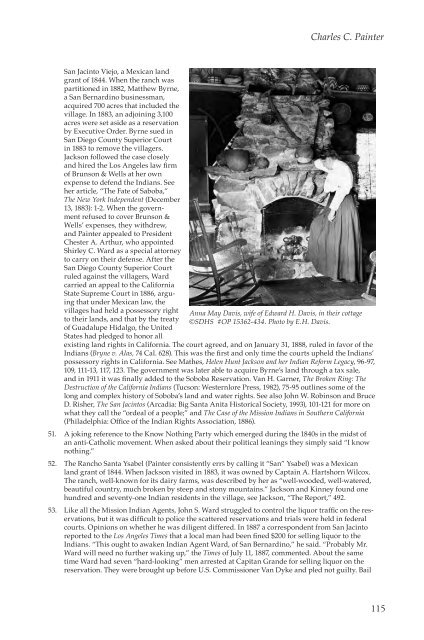The Journal of San Diego History - San Diego History Center
The Journal of San Diego History - San Diego History Center
The Journal of San Diego History - San Diego History Center
You also want an ePaper? Increase the reach of your titles
YUMPU automatically turns print PDFs into web optimized ePapers that Google loves.
Charles C. Painter<br />
<strong>San</strong> Jacinto Viejo, a Mexican land<br />
grant <strong>of</strong> 1844. When the ranch was<br />
partitioned in 1882, Matthew Byrne,<br />
a <strong>San</strong> Bernardino businessman,<br />
acquired 700 acres that included the<br />
village. In 1883, an adjoining 3,100<br />
acres were set aside as a reservation<br />
by Executive Order. Byrne sued in<br />
<strong>San</strong> <strong>Diego</strong> County Superior Court<br />
in 1883 to remove the villagers.<br />
Jackson followed the case closely<br />
and hired the Los Angeles law firm<br />
<strong>of</strong> Brunson & Wells at her own<br />
expense to defend the Indians. See<br />
her article, “<strong>The</strong> Fate <strong>of</strong> Saboba,”<br />
<strong>The</strong> New York Independent (December<br />
13, 1883): 1-2. When the government<br />
refused to cover Brunson &<br />
Wells’ expenses, they withdrew,<br />
and Painter appealed to President<br />
Chester A. Arthur, who appointed<br />
Shirley C. Ward as a special attorney<br />
to carry on their defense. After the<br />
<strong>San</strong> <strong>Diego</strong> County Superior Court<br />
ruled against the villagers, Ward<br />
carried an appeal to the California<br />
State Supreme Court in 1886, arguing<br />
that under Mexican law, the<br />
villages had held a possessory right<br />
to their lands, and that by the treaty<br />
<strong>of</strong> Guadalupe Hidalgo, the United<br />
States had pledged to honor all<br />
Anna May Davis, wife <strong>of</strong> Edward H. Davis, in their cottage<br />
©SDHS #OP 15362-434. Photo by E.H. Davis.<br />
existing land rights in California. <strong>The</strong> court agreed, and on January 31, 1888, ruled in favor <strong>of</strong> the<br />
Indians (Bryne v. Alas, 74 Cal. 628). This was the first and only time the courts upheld the Indians’<br />
possessory rights in California. See Mathes, Helen Hunt Jackson and her Indian Reform Legacy, 96-97,<br />
109, 111-13, 117, 123. <strong>The</strong> government was later able to acquire Byrne’s land through a tax sale,<br />
and in 1911 it was finally added to the Soboba Reservation. Van H. Garner, <strong>The</strong> Broken Ring: <strong>The</strong><br />
Destruction <strong>of</strong> the California Indians (Tucson: Westernlore Press, 1982), 75-95 outlines some <strong>of</strong> the<br />
long and complex history <strong>of</strong> Soboba’s land and water rights. See also John W. Robinson and Bruce<br />
D. Risher, <strong>The</strong> <strong>San</strong> Jacintos (Arcadia: Big <strong>San</strong>ta Anita Historical Society, 1993), 101-121 for more on<br />
what they call the “ordeal <strong>of</strong> a people;” and <strong>The</strong> Case <strong>of</strong> the Mission Indians in Southern California<br />
(Philadelphia: Office <strong>of</strong> the Indian Rights Association, 1886).<br />
51. A joking reference to the Know Nothing Party which emerged during the 1840s in the midst <strong>of</strong><br />
an anti-Catholic movement. When asked about their political leanings they simply said “I know<br />
nothing.”<br />
52. <strong>The</strong> Rancho <strong>San</strong>ta Ysabel (Painter consistently errs by calling it “<strong>San</strong>” Ysabel) was a Mexican<br />
land grant <strong>of</strong> 1844. When Jackson visited in 1883, it was owned by Captain A. Hartshorn Wilcox.<br />
<strong>The</strong> ranch, well-known for its dairy farms, was described by her as “well-wooded, well-watered,<br />
beautiful country, much broken by steep and stony mountains.” Jackson and Kinney found one<br />
hundred and seventy-one Indian residents in the village, see Jackson, “<strong>The</strong> Report,” 492.<br />
53. Like all the Mission Indian Agents, John S. Ward struggled to control the liquor traffic on the reservations,<br />
but it was difficult to police the scattered reservations and trials were held in federal<br />
courts. Opinions on whether he was diligent differed. In 1887 a correspondent from <strong>San</strong> Jacinto<br />
reported to the Los Angeles Times that a local man had been fined $200 for selling liquor to the<br />
Indians. “This ought to awaken Indian Agent Ward, <strong>of</strong> <strong>San</strong> Bernardino,” he said. “Probably Mr.<br />
Ward will need no further waking up,” the Times <strong>of</strong> July 11, 1887, commented. About the same<br />
time Ward had seven “hard-looking” men arrested at Capitan Grande for selling liquor on the<br />
reservation. <strong>The</strong>y were brought up before U.S. Commissioner Van Dyke and pled not guilty. Bail<br />
115






![[PDF] The Journal of San Diego History Vol 52: Nos 1 & 2](https://img.yumpu.com/25984149/1/172x260/pdf-the-journal-of-san-diego-history-vol-52-nos-1-2.jpg?quality=85)

![[PDF] The Journal of San Diego History - San Diego History Center](https://img.yumpu.com/25984131/1/172x260/pdf-the-journal-of-san-diego-history-san-diego-history-center.jpg?quality=85)







